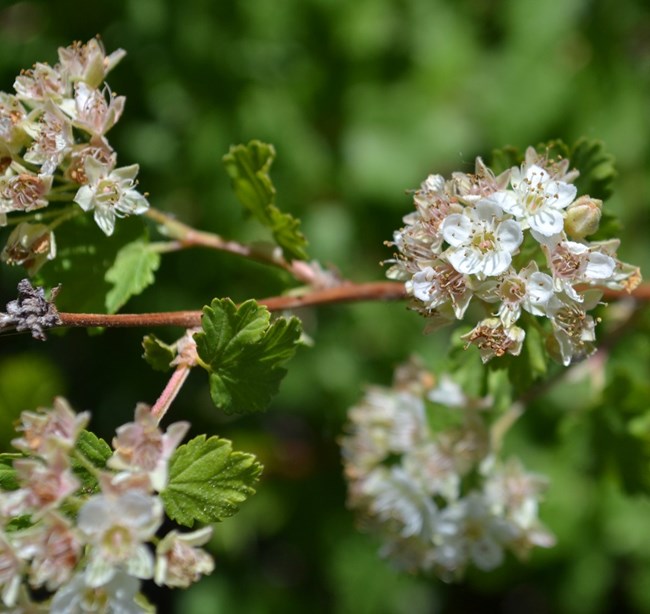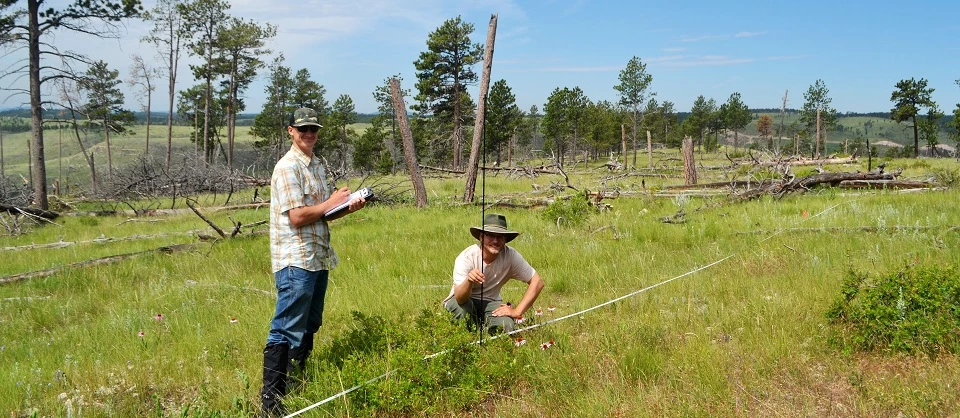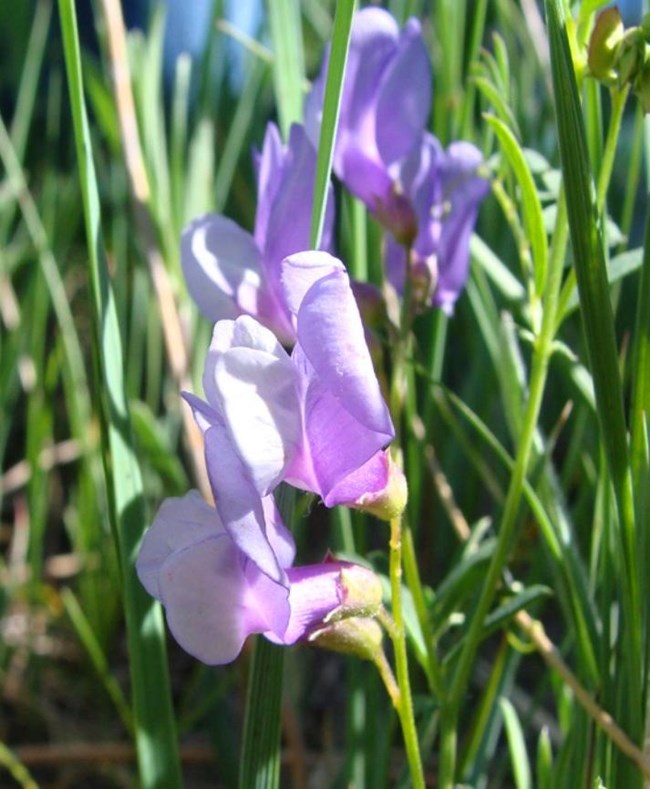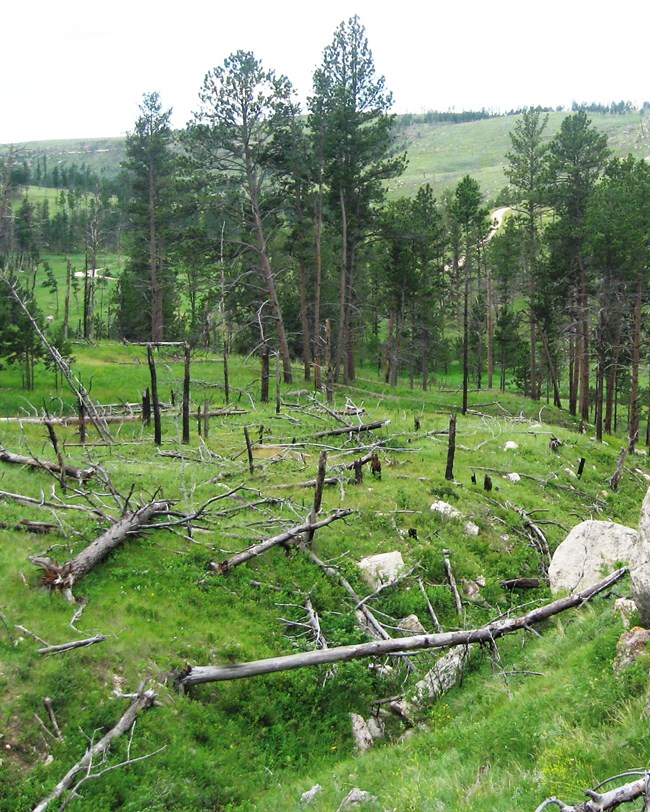Part of a series of articles titled Plant Community Monitoring in Northern Great Plains Network Parks.
Article
Plant Community Monitoring at Jewel Cave National Monument

NPS
Overview
Jewel Cave National Monument is located in the southwestern Black Hills in western South Dakota and contains diverse native ponderosa forest and grassland communities that provide food and shelter to many animal species. The ponderosa pine (Pinus ponderosa) forest of the Black Hills is a unique ecosystem composed of species from the western Rocky Mountains, eastern deciduous forests, northern boreal forests, and surrounding Great Plains. In 2000, about 90% of the park burned in the Jasper Fire and half of the trees were lost.
Plant communities are sensitive to stressors including invasive exotic species, habitat fragmentation, climate change, pollution, and altered fire and grazing patterns. Park management actions, such as prescribed fire, exotic species control, and wildlife management, may also affect plant communities. The Northern Great Plains Inventory and Monitoring Network conducts long-term monitoring of plant communities at Jewel Cave National Monument because it helps us better understand the current health of ecosystems and it can provide an early warning of undesirable changes. Monitoring also helps track the regeneration of the forests after the Jasper Fire.

NPS
What We Monitor
The Northern Great Plains Network established plant monitoring plots throughout the park in 2010. A subset of these plots is monitored each year on a rotating basis. Additional plots in forested areas were monitored in 2011 and 2016 to assess the condition of the forests. At each plot, we record the native and exotic plant species found, seedling and tree densities, and the vegetation cover for each species, a measure of how much ground is covered by the plants.
When woody species are present, we collect tree regeneration and tall shrub density data. We map and tag larger trees and record their status (live or dead) and condition (leaf-discoloration, insect-damaged, etc.). The NPS Northern Great Plains Fire Ecology Program began vegetation monitoring on the park in the late 1990s to evaluate the effectiveness of prescribed burns. In 2010, our network began collaborating with the fire program to continue plant monitoring on the park with revised methods.

NPS
Plant Communities in the Park
There are 397 plants on the Jewel Cave National Monument plant list. In 2018, 132 unique plants were identified on monitoring plots, including one potentially new species for the park, rough false pennyroyal (Hedeoma hispida). More than 270 plant species have been found on plots since plant monitoring first began in 1998. Overall, the park plant communities are in good condition, though exotic plants pose a significant challenge to park management (42 of the 270 species found have been exotic).
The most common plants are native grasses and forbs (flowering plants that are not woody and not a grass or grass-like). The most common graminoids (grasses, sedges, and rushes) were slender wheatgrass (Elymus trachycaulus), the exotic plant, Kentucky bluegrass (Poa pratensis), prairie Junegrass (Koeleria macrantha), and sun sedge (Carex inops). The small shrub, western snowberry (Symphoricarpos occidentalis), and two forbs, American vetch (Vicia americana) and common yarrow (Achillea millefolium), were also common. The most frequent exotic species was Kentucky bluegrass in prairie plots and Canada thistle (Cirsium arvense) in forested plots.
More Details
- Compared to a nearby mixed-grass prairie, the number of plant species at Jewel Cave National Monument is within the historic range, suggesting that plant species diversity is in good condition. A number of factors can affect how many species are present including how often fires occur, grazing, and weather fluctuations.
- There were no significant trends (increases or decreases) in the number of plant species or the amount of vegetation cover for each species over time.
- Ponderosa pine density on the park is similar to that of its estimated density in the 1900s, though on average, trees are smaller. This is likely the result of the Jasper fire.
- Forest regeneration is slowly progressing afer the fire. Ponderosa pine seedlings are increasing in plots.

NPS
Did You Know?
Dead snags, downed wood, and leaves and pine needles on the surface of the ground provide foraging habitat and safe places for small wildlife species, and a place for mosses and fungi to grow. Bats in the Black Hills have recently been found to use even small downed trees as roosting sites. These materials also help replenish nutrients in soil and assist with the prevention of soil erosion, and downed wood can provide "nursery" logs for plant establishment. However, these materials are fuels for fire as well, and if they become too abundant, the risk for a high-intensity fire increases. Natural resource managers have to manage these fuel loads to prevent large wildfires while maintaining enough dead wood and other dead plant materials to maintain their important ecosystem functions.
For More Information
Visit the Northern Great Plains Network website to read more about plant monitoring at Jewel Cave National Monument.
Protocol Contact, Northern Great Plains Inventory and Monitoring Network: Isabel Ashton
Summary by Northern Great Plains Network, updated in 2019
Last updated: November 7, 2019
